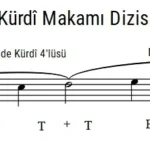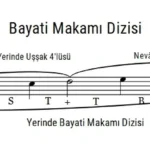One of the oldest modes in Turkish music, and in earlier periods it was known as babatâhir. Abdülbâki Nâsır Dededivided the mode into two branches: “tâhir-i kebîr” and “tâhir-i sagîr”, which over time was shortened to tâhir. It is considered a simple mode and can be defined as a variation of the nevâ makam.
Müşterek Tahir Taksimi – Kanun: Tahir Aydoğdu & Ud: Sedat Oytun
The final note is Dügâh (A).
The melodic progression is descending in character.
It is the descending form of the Neva scale. That is, it is formed by adding the Rast pentachord on Neva to the Uşşak tetrachord on the tonic. Due to its close relation to the Neva makam, it is considered the descending version of Neva and therefore has not been assigned a separate number among the simple makams.
Since the Tahir makam is a descending mode, its primary dominant is the Muhayyer pitch. A half cadence is performed on this pitch. To create a melodic space in the high register, the Uşşak tetrachord located on the tonic of the main scale is transposed symmetrically and identically onto the high tonic Muhayyer.
Since the Tahir makam is a descending mode, the primary dominant is the high tonic Muhayyer pitch. The secondary dominant is the Neva pitch, which is the dominant of the main scale. However, in rare cases, some compositions use Neva as the primary dominant and Muhayyer as the secondary. On the primary dominant Muhayyer, cadences are made with Uşşak flavor, while on the secondary dominant Neva, cadences are made with Rast and Buselik flavors. İstersen bu açıklamayı seyir yapısına bağlayarak karar noktalarını grafikle gösterebilirim. Hazırsan devam edebilirim.
In the main scale of the Tâhir makam, there is a Râst flavor (çeşni) on the Nevâ pitch. However, in descending phrases, the Acem pitch may occasionally be used instead of Eviç due to its descending allure. In such cases, a Bûselik flavor emerges on the Nevâ pitch and a Çârgâh flavor on the Çârgâh pitch, allowing for intermediate cadences (asma karar) on these pitches using the mentioned flavors. An intermediate cadence with Segâh flavor can also be made on the Eviç pitch.

Although the Uşşak flavor appears one whole tone above the Râst flavor on the Nevâ pitch—that is, on the Hüseynî pitch—the Tâhir makam rarely makes intermediate cadences (asma karar) on Hüseynî. In contrast, the Muhayyer makam often descends from Hüseynî, its secondary dominant, to Nevâ and makes an intermediate cadence with Râst flavor on Nevâ.
The key signature includes a 1-comma flat for B (Si) and a 4-comma sharp (bakiye) for F (Fa)
Dügâh (La / A), Segâh (Si♭ koma / B♭ slightly flat), Çârgâh (Do / C), Nevâ (Re / D), Hüseynî (Mi / E), Eviç (Fa♯ koma / F♯ slightly sharp), Gerdâniye (Sol / G), Muhayyer (La / A, one octave above Dügâh).
It is the G (Sol) pitch on the second line (Râst).
Since the makam is descending, it expands toward the high register.
- The Uşşak tetrachord on the tonic pitch is transposed upward symmetrically. This expansion is always used in the introductory progression. We examined it earlier (in the scale section).
- The Râst pentachord on the Nevâ pitch is extended into an Acem-colored Râst scale by adding a Bûselik tetrachord on the Muhayyer pitch. However, this type of expansion is not used in the introductory progression, and the Bûselik flavor on the Muhayyer pitch is not retained. Occasionally, though, when the melody descends to the Nevâ pitch or ornaments above the Muhayyer pitch, the Tîz Bûselik pitch—corresponding to the sound of the Bûselik tetrachord on Muhayyer—is used.

The progression begins around the high tonic, the Muhayyer pitch. After wandering freely in the high register and within the Râst flavor on the Nevâ pitch, a half cadence with Uşşak flavor is made on the Muhayyer pitch. Continuing with mixed phrases, an intermediate cadence is made on the Nevâ pitch as the secondary dominant. Meanwhile, other intermediate cadences are also demonstrated, culminating in a full cadence with Uşşak flavor on the Dügâh pitch.
Note: If, after performing this makam, a cadence is made in its original register using the Bûselik scale or pentachord, the Tâhir Bûselik makam emerges.







